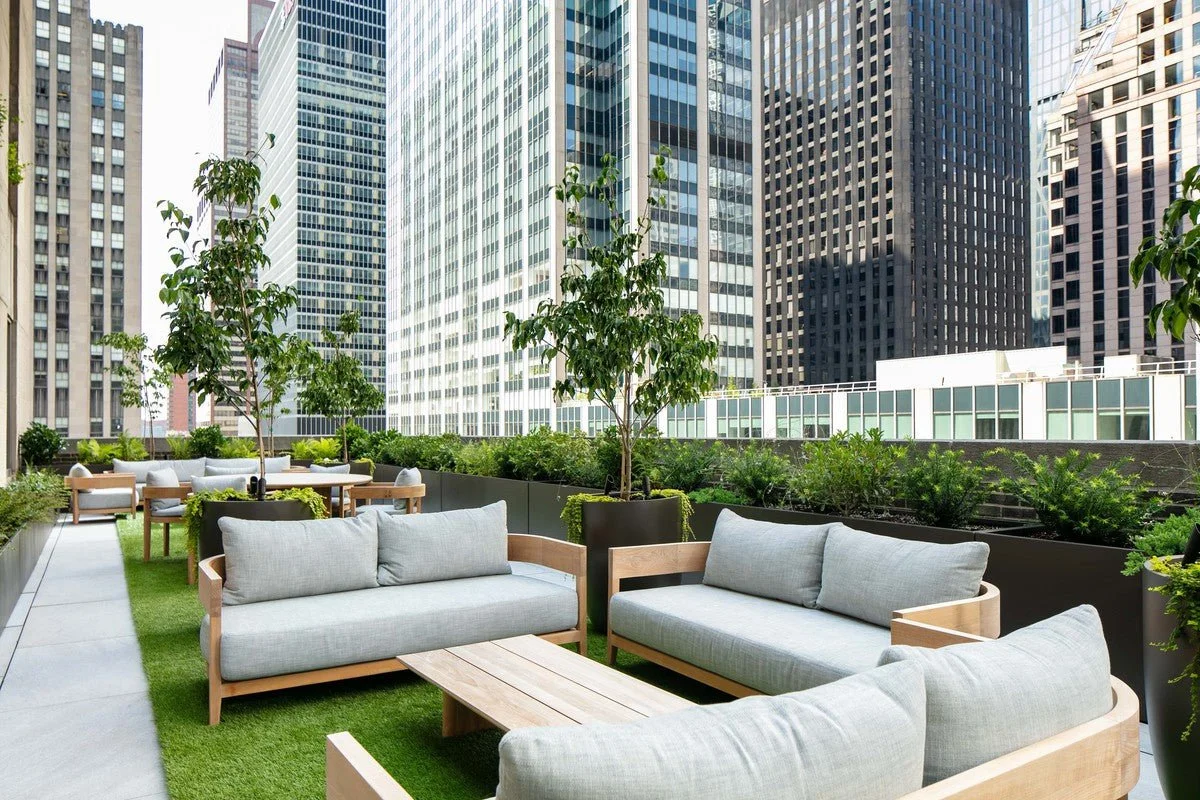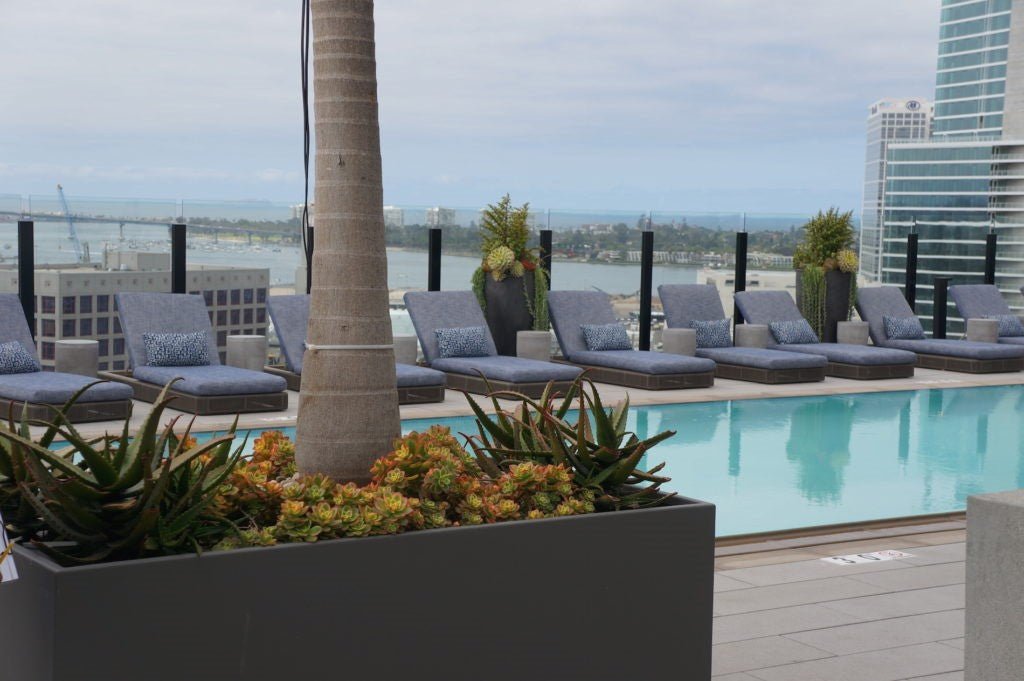Rooftop Gardens: Elevating Design For Urban Buildings
There’s no doubt about it. Rooftop gardens are trending and with good reason. They’re gorgeous, cost efficient, and good for the environment.
As cities grow and building design evolves, developers must optimize their strategic approach for utilizing space.
One of the most innovative ways to optimize existing space is to leverage a part of your building that is currently sitting idle. Enter the rooftop garden.
Whether you own an industrial complex, or just one commercial or residential building, imagine transforming an unused blank flat roof into a luxurious outdoor greenspace with a skyview.
Not bad, right?
But what exactly is a rooftop garden? And what purpose can it serve? In this article, we’ll tell you everything you need to know.
Modern Elite and PurePots Planters at Rockefeller Center in New York, NY
What Is a Rooftop Garden?
Although the name is fairly self-explanatory, a rooftop garden can be so much more than just a garden.
Whether the building’s use is residential or commercial, the rooftop garden addresses the fact that city dwellers have limited space. The rooftop garden provides an opportunity to turn often wasted-real estate into an urban oasis.
The benefits of a rooftop garden aren’t limited to the beauty it provides. The ways in which a rooftop garden can be used are literally limitless. Lush and inviting, the rooftop garden can be used to create everything from recreational opportunities and al fresco dining to an essential spot that promotes architectural and environmental benefits.
Importance to Urban Planning
Quick bit of history. Cities were built out of necessity. The driving purpose was extracting goods. They were never designed to be sustainable.
Today, however, urban planners are tasked with carrying out a wide array of environmentally conscious initiatives. And although successfully deploying those initiatives is a monumental task that will not be solved overnight, rooftop gardens are playing an important role.
That’s why you’ll see more and more rooftops covered with grass, vegetable gardens, and lush foliage in cities across the world.
Aesthetic and Recreational Benefits
Let’s begin with the obvious: rooftop gardens can drastically enhance the visual appeal and utility of any building.
Not only do these gardens enable you to create beautiful, aesthetically pleasing spaces, they also offer the opportunity to create areas where people can relax, unwind, and even work outdoors.
The rooftop garden provides some protection and relief from city life, but also fires a different and often deeper connection to those surroundings.
Architectural Benefits
The primary challenge in designing new buildings or updating existing spaces is driven by population growth and technological innovation. Architects and builders are constantly seeking strategies to achieve a more sustainable and stable path forward.
Rooftop gardens provide substantial benefits from an architectural perspective.
Desirability. Creating a greenspace on your roof essentially replaces black asphalt with a nature preserve. Building owners can lure prospective tenants by marketing their rooftop gardens, which offer residents a place to grow their own fruit, vegetables, herbs, or flowers. Plus, the building itself becomes more marketable
Benefits of Biophilic design. When given the chance, nature heals. A Roman poet once wrote, “This is what I prayed for, a piece of land — not so very big, with a garden and, near the house, a spring that never fails, and a bit of wood to round it off.” This quote sums up the impact biophilic design can have on mental and emotional wellbeing.
Return on Investment. Research indicates that small doses of nature, including “visiting local urban greenspaces” can improve health and psychological wellbeing. Lower stress levels can mean happier and more productive employees and tenants, which means less work for building owners and a higher overall return on investment.
Positive Environmental Impact
Imagine if you could lower the air temperature that surrounds your building, filter and reuse stormwater, and reduce your energy bill.
With the potential to do all this and more, rooftop gardens are creating an enormously positive environmental impact by:
Lowering Air Temperatures. Air temperatures in cities can be as much as 22 degrees Fahrenheit warmer than suburban areas. This happens because roads and buildings absorb, store, and re-release the heat from the sun’s rays. And there are simply more roads and buildings in the city.
But by incorporating rooftop plants into building design, you can reduce the amount of heat that’s absorbed and use less energy for cooling. The plants cool the surrounding air through a process called evapotranspiration. It’s like having an outdoor air-conditioner.
Using Rainwater Efficiently. Plants in rooftop gardens retain rainwater. These plants can also moderate the temperature of the roof and act as filters for runoff. The benefits here are twofold: the water can be reused and less runoff means a lower possibility of local flooding.
Reducing Energy Consumption. A rooftop garden adds a top layer of insulation to the building, so the building needs less heating and air-conditioning.
It’s simply a matter of time before the rest of the world catches up with countries like Canada, France, and Switzerland, all of whom require by law that new commercial and residential buildings have at least “a partly green” rooftop.
Modern Elite Custom Planters at Alexan ALX Luxury Apartments San Diego, CA
4 Rooftop Gardens With PureModern Planters
At PureModern, we’ve collaborated on rooftop garden design projects with some pretty incredible partners.
30 East Huron
We provided benches for the award-winning rooftop roof deck at 30 East Huron in Chicago, Illinois. Designed by Topiarius, the sun and pool deck turned the building’s rooftop into an incredible communal area equipped with planters, BBQs, seating, and more.
613 Baltic
Baltic, located in the sought after neighborhood of Park Slope, has eleven stories of luxury condominiums and was developed by JDS Development Group. G&M works, a landscape contractor, utilized PureModern’s custom aluminum planters to grace the terrace on the second floor and a roof deck. The roof decks were complete with seating areas for lounging, dining, and grilling. These planters were fabricated to hold lights when needed and were powder-coated in matte black.
Rockefeller Center
Tishman Speyer, a real estate developer and operator with a global presence, called on Kim Hoyt Architect & Landscape Architect P.C. to design spaces at the Rockefeller Center in Midtown Manhattan. PurePots Fiberglass and custom Modern Elite Planters were used to add greenery to two terraces located on the 15th floor.
The Towers at Emeryville
Brent Cottong + Associates did a stellar job separating a very large second-floor roof deck at The Towers at Emeryville into a multi-use space complete with a bocce ball court using Modern Elite Cube Planters. This space also includes two sun-protected lounge areas screened by the ornamental grasses and a few benches also flanked by grasses. Any professional looking for a place to clear their mind or connect with a fellow co-worker will be happy to enjoy this well-designed roof deck.
With all the benefits offered by rooftop gardens, it’s no wonder we’re seeing them becoming more and more prevalent in urban environments across the world.
Learn More
Whether you’re working on a commercial or residential project, incorporating a rooftop garden into your design could elevate its visual appeal and save you and your clients money over time.
If you’ve got questions about the right planters for your rooftop garden, request a quote today. Our experts will be happy to help you find the perfect fit.





















